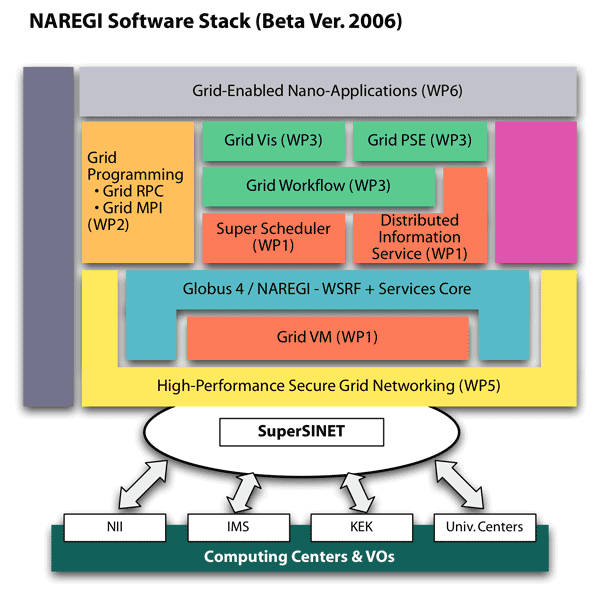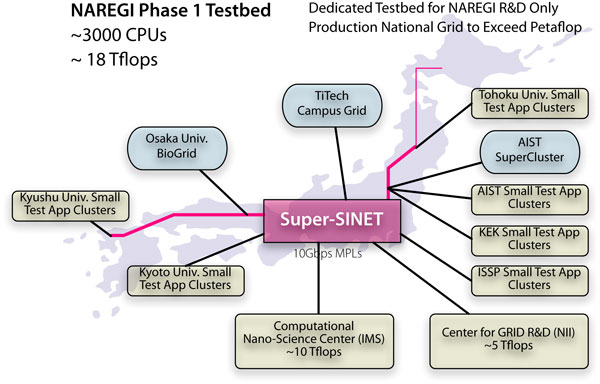The National Research Grid Initiative (NAREGI)2, is one of the core projects within CSI. It started as the five-year Japanese National Grid Project 2003–2007, with over $100 million dedicated budgetary allocation. It is hosted by NII and led by Ken-ichi Miura. The chief aim of NAREGI is to develop a set of grid middleware to serve as a basis for CSI and other international grid infrastructural efforts. It will also serve as the centerpiece for constructing a nationwide research grid infrastructure. (Recent decisions have been made to extend NAREGI beyond 2007 via consolidation with the recent petascale computing national project.)
To achieve these goals, over 100 professional software developers from computing vendors such as Fujitsu, NEC, and Hitachi are working together in groups called working packages (WP) on a comprehensive middleware stack (Figure 3) under the leadership of NII professors who technically supervise the respective WPs; this is a unique combination of academic and industrial talents not seen in other major international grid projects. NAREGI is also strongly investing in the standardization of grid middleware, especially the OGSA (Open Grid Services Architecture) in GGF (the Global Grid Forum)3, and has actively adopted the standards of other organizations whenever possible. NAREGI will also collaborate with other international grid infrastructure projects, such as the TeraGrid and OSG in the U.S., EGEE and DEISA in Europe, as well as national-level projects in the Asia-Pacific region. Starting in 2005, NAREGI has held several interoperability meetings between TeraGrid and EGEE, and plans to set milestones so that the middleware stacks of the different projects will be interoperable at various levels in order to host virtual organizations on international scales.
Another essential aspect of NAREGI is the inclusion of nanoscience as an "early adopter" application area and a virtual organization (VO). The Institute for Molecular Science (IMS) located in Okazaki, Japan, is serving as the VO hosting institution. The experimental deployment of grid-enabled nanoscience applications over the NAREGI testbed, together with a production environment that will be hosted by the computing centers, will be significant in terms of the scale of the computational requirements, and it will affect academia and industry users who work in nanoscience and nanotechnology.
NII, which hosts the overall project as well as the Center for Grid Middleware Research and Development, and IMS collectively operate the dedicated NAREGI testbed. The testbed uses the Super SINET optical network as the underlying network infrastructure. It currently facilitates nearly 18 Tflops of computing power distributed over nearly 3000 processors (Figure 4) and is in heavy use for middleware development and grid-enabled nanoscience applications. The presence of a dedicated non-commercial testbed has proven absolutely essential in enabling large teams to collaborate toward reaching R&D goals and fostering integration.
The project's initial milestone of internal alpha delivery of middleware was met in the spring of 2005, and the near-production quality and standards-setting/compliant beta version will be ready for the Global Grid Forum 17 in Tokyo in May 2006. Several virtual organizations will also begin operation in 2006, including ones for nanoscience, high-energy physics, and the consortium of major university centers. There will be releases over the next two years to refine and enhance the middleware capabilities so that NAREGI can be used in a 24/7 fashion at major computing centers around the world.
As of early 2006, the project target of achieving a 100 Tflop-scale, CSI production grid seems easily achievable in terms of the computing capacity of the facilities involved in the project. Thus, to support grids that are beyond the petascale, the NAREGI project will be "upscaled" starting April 2006. That is, NAREGI will become part of the new petascale high-performance computing initiative, aiming to construct a computing environment that will be centered around a next-generation Earth Simulator-class machine that will exceed 10 Pflops by 2011, and will be supplemented by a fleet of centers, each of which will host a petascale machine, constituting a nationwide multi-petascale grid. The NAREGI project will thus last until the spring of 2011 or even beyond, with developments to focus on hosting a grid of enormous computing capacity. NAREGI will collaborate with other CSI efforts, such as the national-scale UPKI , so that every researcher and student can have access to the national grid.








